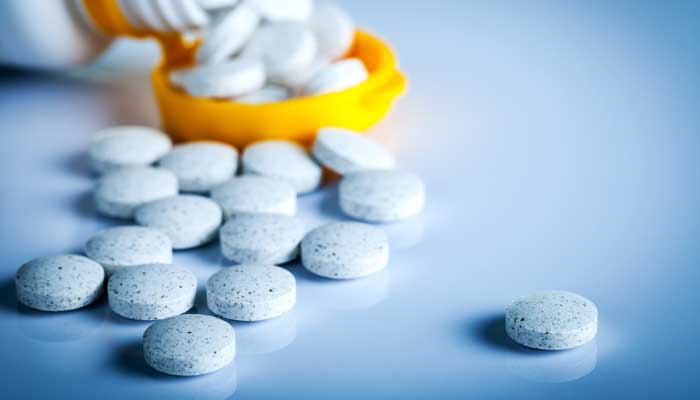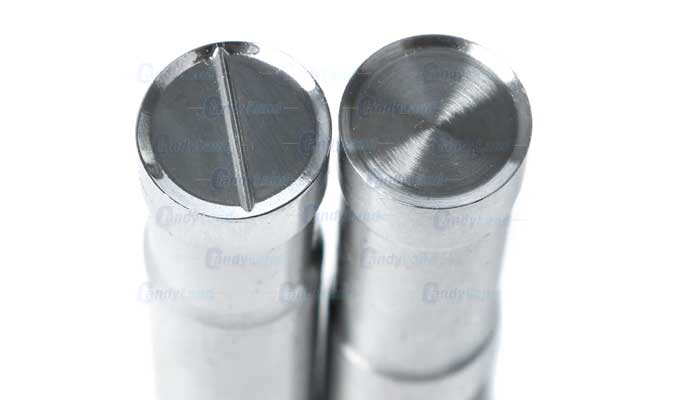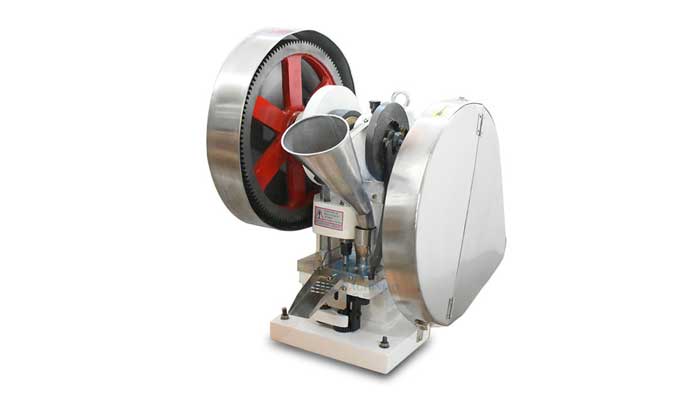Due to the comprehensive factors of tablet prescription, production process, operation technology and mechanical equipment, loose tablets, lobes and sticky punch may occur during tablet pressing, which needs to be analyzed, found out the causes and solved. The common problems are as follows.
Loose tablets
Loose tablet refers to the tablet hardness being small, loose and fragile, although pressed with greater pressure, the tablet will be placed between the middle finger and index finger, gently pressed with the thumb is broken, the tablet hardness does not meet the requirements. The reasons and solutions for loose tablets are as follows.
The compressibility of raw materials and excipients is not good
Such as raw and auxiliary materials have good elasticity, in a larger pressure can be formed, but once placed very easy to produce loose tablets due to expansion, this situation should be added to the raw materials with strong plasticity of auxiliary materials, such as compressible starch, microcrystalline cellulose, lactose, calcium sulfate, calcium hydrogen phosphate, etc., to reduce the elasticity of its return force to eliminate loose tablets. The elasticity of the raw material is also related to the morphology and can be crushed if necessary. For example, needle or flake crystals are not easy to press, and can be crushed first and then pressed.
The influence of lubricant
The amount of lubricant is not appropriate, it will cause a loose piece. Magnesium stearate is the most commonly used lubricant, but it has a negative effect on the hardness of some tablets, its hardness of the tablets with compressible starch as an auxiliary material, but stearic acid and stearyl alcohol on the hardness of the tablets with compressible starch as an auxiliary material has a relatively small negative effect.
Effect of moisture in granules
Completely dried granules have a large elastic deformation, and the hardness of the tablets pressed into them is poor. The hardness of the tablet pressed into the granules containing the right amount of water is better, but too much water will reduce its hardness, so the water content of the granules should be moderate. If the amount of binder or wetting agent is not enough or improperly selected, it will lead to loose particles, and fine powder, even if the pressure is increased when pressing the tablets can not overcome this problem, then you can choose another strong viscous binder or wetting agent to re-form the particles.
The punch length is not the same
If the tablets are subjected to a different pressure, the small pressure will produce loose tablets. When the lower punch plug dies, the lower punch can not be flexible down, the die hole in the particle filling is not enough and will also produce loose tablets, which should be changed punch.
Compression conditions
Pressure size and hardness are closely related, compression time also has an important significance. The development of plastic deformation requires a certain amount of time, such as the compression speed is too fast, and the plasticity of the material will also increase the tendency of elastic deformation, making it easy to produce loose tablets. A tablet press with a pre-pressure device is beneficial to tablet compression. In addition, after the tablets are pressed and left in the air for too long, they will absorb water and expand, which will also cause loose tablets, so attention should be paid to the preservation of tablets.
the lobes
Lobe, also called top crack, refers to the phenomenon that after the tablet is pushed out from the die hole, a thin layer facing upward is cracked and falls off due to vibration, sometimes it even cracks into two halves from the waist of the tablet, but it happens less often. The causes and solutions of the lobe are as follows.
The characteristics of the drug itself
The crystalline shape of the raw material drug has a direct influence on the formation of the tablet. If the crystals of the API are in the shape of flakes, needles or spheres, and if the crystals are pressed directly without treatment, the problem of lobing is likely to occur. In this case, the API can be fully crushed before pressing, and then passed through a 100 mesh or finer sieve, and then pressed.
If the particle size of the API is small, the binding force is stronger and the pressed tablets are harder. Experiments have shown that the hardness of tablets such as lactose, sodium chloride and urotropine increases as the particle size of the API decreases. The elasticity of the API is easy to produce lobes when pressing the tablets, can add powdered sugar or other methods to overcome this. The reason is mainly in the granulation process, part of the powdered sugar is dissolved and absorbed by the fiber, so the elasticity of the fiber is reduced.
Selection of binder
Poor compressibility of the drug powder added to the binder, with its surface tension and capillary force to make the powder stick together. Generally add high cohesion of hydrophilic polymer compounds, such as methylcellulose, hydroxypropyl methylcellulose, etc.; can also use a certain degree of permeability of the viscous liquid gum paste, which can penetrate into the fiber or other elastic drug powder particles inside, to improve its plasticity, such as gelatin pulp, gum Arabic pulp, yarrow pulp, polyvinylpyrrolidone, etc. The adhesion of the adhesive in the particle is not enough as well as the particle is too fine, too coarse or too much fine powder, which can make the capacity in the mold hole is not uniform. This situation can be mixed with particles of better viscosity and then pressed, or sieve part of the fine powder without affecting the content.
Moisture in the particles
Moisture in the particles is an indispensable condition for tablet forming, which makes the plasticity of the powder particles increase, while the extrusion of moisture in the compression process can form a thin layer on the outer surface of the powder, which facilitates the particles to approach each other and produce sufficient cohesion. The moisture in the granules is generally controlled at about 3%, too much or too little will affect the hardness of the tablets. More oily components in the granules will weaken the adhesion between the granules, which may be caused by excessive drying of the granules and the loss of too much crystalline water for drugs containing crystalline water. This situation can be absorbed with absorbent to absorb the oil components before mixing with the particles and then pressed tablets, or mixed with particles containing more water and then pressed tablets, or sprinkle a layer of water on the ground, the dry particles laid in the sieve, placed on the shelf far from the ground, so that the particles absorb water and then pressed tablets, but this method is not suitable for mass production. Generally, sprayed with ethanol for airtight storage.
Excessive pressure
Such as compound licorice tablets, etc., in the case of excessive pressure is easy to produce lobes, adjust the pressure can be solved.
Mould is not in accordance with the requirements
The mold wears out gradually after a long time so that the upper punch does not match with the die ring and the punch rolls inward, resulting in uneven pressure, which causes lobes due to excessive pressure on the tablet part. When the die ring is used for a long time, the friction in the middle of the die hole will increase, resulting in the middle diameter being larger than the diameter of the mouth, which will also produce lobes when the tablet is ejected, this situation can be solved by changing the die ring.
the mold up and down sticking together
The “sticky punch” is that when pressing the tablet, there is often fine powder sticking on the punch and die ring, resulting in the tablet surface not being smooth, uneven or dent. This is more likely to happen when there are words or logos engraved on the die. The reasons and solutions for the occurrence of sticking on the top and bottom of the die are as follows.
The granule is too damp
The particles are not dry enough, the lubricant dosage is insufficient or unevenly distributed, and the room temperature and humidity are too high. The treatment method is to re-dry or add lubricant appropriately and keep the room dry. If there are volatile substances in the granule, it can be spread into a thin layer and placed in the dry warm air, so that the humidity can be reduced to the required level when the lubricant is added to press the tablet. At this time, there is still a loss of volatile substances, but not too much. Particularly, the granules containing moisture-attracting drugs should be prevented from absorbing moisture.
The rough surface of the die
The surface of the die is rough, such as the surface of the new punch is rough, or long-used inadvertently damaged, or the punch is engraved too deep, the strokes are not round and blunt in shape and have angles. If the anti-rust oil on the punch is not wiped clean before use, gasoline can be used to clean it.
Insufficient amount of lubricant or uneven mixing
In the treatment method, the former should add the amount, the latter should be fully mixed. Some drugs are easy to happen the mold upper and lower adhesion. Therefore, at the beginning of tablet pressing, the pressure can be increased and the lubricant can be added appropriately, after the mold is heated up, the phenomenon of sticking up and down the mold can be improved.
stacked tablets
Stacked tablets are two tablets stacked together. When pressing the tablets, due to the sticky punch or the upper punch rolled edge and other reasons, the tablets stick to the upper punch, and when continuing to press the tablets, the die hole which has been filled with particles will be pressed into double tablets, or due to the lower punch up position is too low, the tablets which have been pressed are not sent out in time and the particles are added to the die hole and pressed into thick tablets repeatedly. This pressure is relatively too large and the machine is vulnerable to damage. This problem can be solved by changing the punch, polishing with sandpaper or overhauling the regulator.
Tablet weight difference
Tablet weight difference refers to the difference in tablet weight exceeding the specified limit. The main reasons and solutions are as follows.
Unbalanced feeder
For example, the height of the two feeders in the front and rear of the double track tablet press is different, and the speed of adding particles is not the same, as well as the feeder blockage, viscous and moisture-priming drugs do not flow well, such as the feeder particles mixed with fibers and other foreign matter, resulting in the number of particles added to the die hole is reduced and affects the weight of the tablets. This situation should be stopped to check, depending on the specific situation to solve.
The difference between the coarse and fine particles
The particle flow rate is different when pressing the tablet, resulting in the number of particles filled into the die hole is not the same. This situation can be solved by sieving for more fine powder or re-formulate the particles.
the number of particles in the feeder is not the same
This situation can be solved according to the specific situation.
Mold blockage
If you find that the mold is clogged, you should correct it in time, remove the blocked down punch and wipe the down punch and die hole to solve the problem.
Inflexible punching when the mold is blocked
This situation can be solved according to the specific situation.
discoloration or surface spots
raw materials and excipients of the color difference is large
If the color difference between raw materials and excipients in the compound preparation is very large, and in the granulation before the fine grinding or mixing, it is easy to produce spots, which need to be reworked, that is, when pressing the lubricant used by the fine sieve and fully mixed with the particles and then pressed tablets can improve this phenomenon.
Uneven particle tightness
The particles are too hard, or the particles of colored tablets are unevenly tightened and loosened, and the particles should be handled loosely in this case, and the colored tablets should be granulated with ethanol as a wetting agent (preferably without starch slurry granulation), so that the particles made are more uniform in thickness and tightness, and the tablets pressed into them are less likely to have spots.
The punch is not clean
When pressing the tablets on the impulse too much dirt, with the upward movement of the impulse, dirt falls in the particles to produce oil spots, then you can install a rubber band on the impulse to prevent the dirt from falling into the particles, and should often wipe the impulse and rubber band.
react with the metal
Moist drugs and metal contact is easy to discolor, this situation can control the humidity and reduce the contact between the drug and the metal surface.
Delayed disintegration
the nature of raw materials and excipients
The hydrophilicity or hydrophobicity of raw materials and excipients and their solubility in water have a great relationship with the disintegration and dissolution of tablets. The contact angle between the surface of raw materials and excipients and aqueous media is greater than 90, capillary reverse action, so that aqueous media is not easy to penetrate into the interior of the tablet, making it difficult to disintegrate and dissolve. Among the hydrophobic excipients, hydrophobic lubricant is the most common.
If the drug is hydrophobic or insoluble while the excipient is hydrophilic or soluble, the excipient can improve the disintegration and dissolution of the tablet, i.e. improve the hydrophobicity of the whole tablet, so that the aqueous medium can penetrate into the tablet and then disintegrate and dissolve. The addition of surfactants can improve the wettability of tablets and prevent the flocculation of drug particles, so that they can maintain a large surface area, thus helping the disintegration and dissolution of tablets. In the process of compression, the strength of plastic deformation and particle size of raw and auxiliary materials will also have an impact on disintegration and dissolution.
Pressure size
Generally, as the pressure increases, the tablet porosity and pore size become smaller, the disintegration time is prolonged, and the dissolution becomes slower. However, the dissolution rate does not always slow down with the increase of pressure.
Mixing method
The drug in the excipient dispersion area is large, the dissolution rate is fast, especially insoluble drugs, mixing methods are different, the dissolution rate is also different. The drug can be first dissolved in a suitable solvent and then mixed well with the filler, and then volatilized to remove the solvent, and after drying, the drug forms tiny crystals and the excipients are mixed. Insoluble drugs can be used in filler grinding and crushing methods to reduce the cohesion of drug particle re-agglomeration in the crushing process. Water-soluble filler can improve the hydrophobicity of some difficult-to-dissolve drugs, so that the rapid dissolution of the excipients are fine particles dispersed in the dissolution medium, increasing the surface area of its dissolution to accelerate dissolution.
These two mixing methods, in general, the former method is easier to disperse and fine and uniform, but due to the volatile solvent, it is possible to increase the crystallization, so sometimes it does not significantly improve the drug dissolution effect, while the latter method can obtain a better dissolution effect.
In the production, the disintegration time limit of the tablets made is encountered to fail, the following three methods can be used to solve.
(1) adding disintegrants with stronger disintegration effect, such as 2% – 5% sodium carboxymethyl starch.
(2) To ensure the quality of the finished tablet, mix it with well-disintegrated granules in a certain proportion before pressing it.
(3) Add a certain amount of disintegrant first, and then mix well with the disintegrating particles before pressing the tablets.
tablet uniformity failed
Small dose tablets in the drug and excipients between the uniformity of dispersion and weight requirements compared to the uniformity requirements are more stringent. Because the weight of qualified is not equal to the content of qualified, and content in line with the provisions to ensure the accuracy of the dose. The main factors affecting the uniformity of tablets are mixing irregularities and migration of soluble components. This article mainly introduces mixing unevenness.
The influence of “ingredient weight ratio” on “mixing uniformity
The “weight ratio” of each component has an important influence on the “mixing uniformity”, and special attention should be paid when mixing small amounts of drugs with other drugs or excipients. If a small number of drugs and large amounts of other components are directly mixed, generally not easy to mix uniformly, using the method of progressive dilution (with research method) can be mixed uniformly, but its content fluctuations are still large.
The use of the solvent dispersion method, that is, a small number of drugs first dissolved in a suitable solvent and then mixed with other components, can often be mixed very evenly, and its content fluctuations are smaller. For example, if the content of digoxin is small, and digoxin and excipients are directly mixed, the mixing uniformity does not meet the requirements. With the recursive dilution method, the uniformity of the product can meet the regulations, but the content fluctuations are still very large. With the solvent dispersion method, the uniformity of drug mixing is good.
The influence of raw materials and excipients particle size
Drug dose is small, when the particles are large, the number of particles is not enough in the other components of uniform dispersion, resulting in the inability to mix uniformly, if the particles of excipients are too large, it is not easy to mix uniformly. In this case, before mixing, must be crushed, so that the particles of each component are relatively small and as much as possible the same size.
The impact of particle morphology on the uniformity of mixing
In powder particle morphology such as complex, rough surface, the friction between the particles is greater, mixed evenly and then not easy to separate, to maintain a uniform state. For example, when aspirin is mixed with lactose, if crushed aspirin and crushed lactose are mixed, the homogeneity is better, probably because it is not easy to separate again after mixing. If aspirin is mixed with spray-dried lactose (mostly in a spherical shape), it is difficult to maintain uniformity because it is separated again during the processing. The raw and auxiliary materials absorb moisture, which also has an impact on the uniformity of the mixture.
The effect of porosity of blank particles
When using the solvent dispersion method to mix small doses of ingredients with excipients or blank particles, due to the different porosity between the particles, the amount of absorbed drug solution varies, so the uniformity of the mixture is not good. For example, when reserpine was dissolved in dichloromethane and mixed with blank particles made from calcium carbonate, the reserpine content was high in the larger particles (below 12 mesh and above 22 mesh) and low in the smaller particles (below 44 mesh and above 60 mesh). The porosity of large particles is higher and that of small particles is lower, and the variation of the content of lisinopril is related to the porosity of the particles. In the process of tablet pressing, due to vibration, etc., the large and small particles are easily stratified, and the small particles sink to the bottom, which causes both the difference of tablet weight and the poor mixing uniformity of the tablets.



